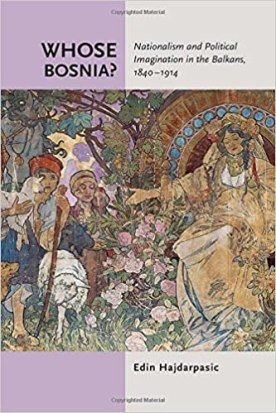Whose Bosnia ? Nationalism and Political Imagination in the Balkans, 1840-1914

Review of Whose Bosnia ? Nationalism and Political Imagination in the Balkans, 1840-1914, Edin Hajdarpasic (Ithaca and London: Cornel U.P., 2015; pp. xii + 271. £34.00). Originally published by the English Historical Review.
Although Bosnia-Herzegovina has been the subject of a considerable amount of academic study in the past quarter century, this has been disproportionately focused narrowly on its recent history and politics and contemporary society – since 1992, and particularly since 1995. Few have been willing to explore the country’s earlier history – for all that the events of the 1990s and after cannot be understood without a proper knowledge and understanding of this earlier history. It is therefore a pleasure to discover Edin Hajdarpasic’s study of nationalist ideas and texts in the period 1840-1914. Through extensive research into texts previously neglected by scholars outside of the former Yugoslavia, and even by many inside it, he provides a wealth of valuable new information. This work is richly illustrated with quotes by Bosnian, Croatian and Serbian authors which any true Bosnia specialist will find fascinating.
The author pertinently compares nationalism in Bosnia-Hercegovina to the popular video game Tetris, in which there is no definite or stable solution, but in which every solution adds a layer while throwing up new gaps that need filling, so that there is ceaseless motion and struggle. He denies that the nationalist imaginations of youth in Bosnia-Hercegovina before 1914 were a ‘ticking time-bomb’ leading teleologically to the Sarajevo assassination, instead repeating a quote from the Italian avant-garde writer Giorgio Manganelli, to describe them as ‘a ticking sound that simulates thought and measures out… hours which still do not exist, which have not yet begun’ (p. 160) – something that will hardly be controversial. Hajdarpasic in general does not give broad, sweeping conclusions; as the author notes, each of the chapters ‘can be read as a thematic essay in itself’ (p. 15), and is likely to provoke most interest for the observations it makes along the road.
This work is essentially an analysis of texts, which are mostly viewed in their own right, with relatively little wider contextualisation – almost as if there were ‘nothing outside the text’, as postmodernists are said to believe. This restricts the scope of the analysis. For example, the author notes that the poem ‘Sad Bosnia’ by Mate Topalovic had immense influence on the discourse of subsequent generations of politically aware South Slavs, in terms of establishing an image of Bosnia-Hercegovina’s suffering under foreign rule – first Ottoman, then Habsburg. This is an important observation. Yet there is almost no evaluation here of whether Bosnia-Hercegovina was indeed ‘sad’; i.e. of how oppressed and suffering or otherwise its population really was. Hajdarpasic discusses at some length the writings of Petar Kocic, a radical agitator on behalf of peasant economic rights and interests in the Austro-Hungarian period. Again, Kocic is a fascinating figure who has been almost wholly neglected by Western scholars of Bosnia, and Hajdarpasic is right to focus on him. But there is almost no actual discussion of what these peasant interests or peasant conditions might have been, or of how valid his ideas consequently were. Hajdarpasic puts forward the interesting thesis that ‘the Habsburg administration played a pivotal role in constructing Bosnian youths as an unstable – and possibly violent – political subject’ (p. 147); in other words, that the imperial regime’s nervous discourse became a sort of self-fulfilling prophecy that culminated in Gavrilo Princip and the Sarajevo assassination. But there is no proper consideration of the political, social or economic factors that might have produced an assassin like Princip, nor of the fact that he was acting as an agent of the Black Hand – an organisation established by army officers in neighbouring Serbia, with very different backgrounds to Princip’s; Dragutin Dimitrijevic-Apis, the mastermind behind the assassination, does not get a mention.

What historical contextualisation that is given is not always reliable. Thus, Hajdarpasic claims that ‘Ilija Garasanin and Jovan Ristic took great pains to keep Serbia out of any potentially disastrous wars’ (p. 101), which is the opposite of the truth, since it was Ristic who engineered Serbia’s disastrous war with the Ottomans in 1876-77, while Garasanin had been dismissed as prime minister by Prince Mihailo in 1867, precisely because he wanted to drag Serbia into a suicidal war with them. The author claims that in the uprising of 1875-78 ‘no great national movement took place in Bosnia itself’ (p. 106), even though the uprising produced an all-Bosnian rebel assembly and government with concrete national goals. He claims in relation to the uprising that ‘there was no significant mobilisation of South Slavic youth for action in Ottoman Bosnia’, citing the examples of the United Serbian Youth and the Bosnian activist Vaso Pelagic, who he says ‘exercised little influence in his home province after his expulsion from Sarajevo in 1869’ (pp. 133-134). Yet activists of the United Serbian Youth, in particular those grouped around Svetozar Markovic, had been preparing for the uprising in Bosnia since 1871 and actively supported it once it broke out, while Pelagic himself played an active role in it. One of the most vocal supporters of the uprising, Markovic’s friend and follower, the young Nikola Pasic, was hardly an insignificant figure in Serbian history. Even Hajdarpasic’s own reference mentions ‘hundreds’ of Serbian, Croatian and Slovene youth joining the uprising (p. 244). Hajdarpasic cites Slobodan Jovanovic as someone who was ‘not enthused with the exhaltation of heroic action over the seemingly quiet everyday life’ (p. 153). Yet Jovanovic is a bad example, given he was a political ally of Dimitrijevic-Apis – war-monger, adventurer and regicide par excellence – and was subsequently part of the conspiratorial circle that overthrew the Belgrade government in March 1941 to plunge Yugoslavia into war with Germany.
Hajdarpasic has produced a work throwing valuable light on nationalist thinking in Bosnia-Herzegovina in the nineteenth and early twentieth centuries, one that will be a resource for all future scholars of the subject. It is to be hoped that the latter will further explore and develop the themes that it raises.
-
Archives
- July 2023 (1)
- June 2023 (1)
- April 2023 (1)
- April 2021 (1)
- September 2020 (2)
- August 2020 (1)
- June 2020 (2)
- May 2020 (1)
- January 2020 (2)
- October 2019 (1)
- September 2019 (3)
- October 2018 (1)
-
Categories
- Abkhazia
- Abortion
- Afghanistan
- Albania
- Alex Callinicos
- Anti-Semitism
- Arabs
- Armenians
- Australia
- Balkans
- Basque Country
- Biljana Plavsic
- BNP
- Bosnia
- Brexit
- Britain
- Bulgaria
- Catalonia
- Caucasus
- Central Europe
- Chechnya
- Conservatism
- Crimea
- Croatia
- Cyprus
- Darfur
- Denmark
- East Timor
- Education
- Egypt
- Environment
- European Union
- Faroe Islands
- Fascism
- Feminism
- Finland
- Former Soviet Union
- Former Yugoslavia
- France
- gender
- Genocide
- Georgia
- Germany
- Greece
- Greenland
- Heathrow
- Holocaust denial
- Iceland
- Immigration
- India
- Indonesia
- Iran
- Iraq
- Ireland
- Islam
- Islamophobia
- Israel
- Italy
- Jews
- Kosovo
- Kurds
- LGBT
- Liberalism
- Libertarianism
- Libya
- London
- Macedonia
- Marko Attila Hoare
- Middle East
- Misogyny
- Moldova
- Montenegro
- NATO
- Neoconservatism
- Neoliberalism
- Netherlands
- Norway
- Pakistan
- Palestine
- Political correctness
- Portugal
- Racism
- Red-Brown Alliance
- Russia
- Rwanda
- Sami
- Scandinavia
- Scotland
- Serbia
- Slovakia
- Slovenia
- South Ossetia
- Spain
- Sudan
- Svalbard
- Sweden
- SWP
- Syria
- The Left
- Transnistria
- Transphobia
- Transport
- Turkey
- UCU
- Ukraine
- Uncategorized
- University College Union
- White supremacy
- World War II
- Zimbabwe
-
RSS
Entries RSS
Comments RSS
 A blog devoted to political commentary and analysis, with a particular focus on South East Europe. Born in 1972, I have been studying the history of the former Yugoslavia since 1993, and am intimately acquainted with, and emotionally attached to, the lands and peoples of Croatia, Bosnia-Hercegovina and Serbia. In the summer of 1995, I acted as translator for the aid convoy to the Bosnian town of Tuzla, organised by Workers Aid, a movement of solidarity in support of the Bosnian people. In 1997-1998 I lived and worked in Sarajevo, Bosnia-Hercegovina. In 1998-2001 I lived and worked in Belgrade, Serbia, and was resident there during the Kosovo War of 1999. As a journalist, I covered the fall of Milosevic in 2000. I worked as a Research Officer for the International Criminal Tribunal for the former Yugoslavia in 2001, and participated in the drafting of the indictment of Slobodan Milosevic.
A blog devoted to political commentary and analysis, with a particular focus on South East Europe. Born in 1972, I have been studying the history of the former Yugoslavia since 1993, and am intimately acquainted with, and emotionally attached to, the lands and peoples of Croatia, Bosnia-Hercegovina and Serbia. In the summer of 1995, I acted as translator for the aid convoy to the Bosnian town of Tuzla, organised by Workers Aid, a movement of solidarity in support of the Bosnian people. In 1997-1998 I lived and worked in Sarajevo, Bosnia-Hercegovina. In 1998-2001 I lived and worked in Belgrade, Serbia, and was resident there during the Kosovo War of 1999. As a journalist, I covered the fall of Milosevic in 2000. I worked as a Research Officer for the International Criminal Tribunal for the former Yugoslavia in 2001, and participated in the drafting of the indictment of Slobodan Milosevic.